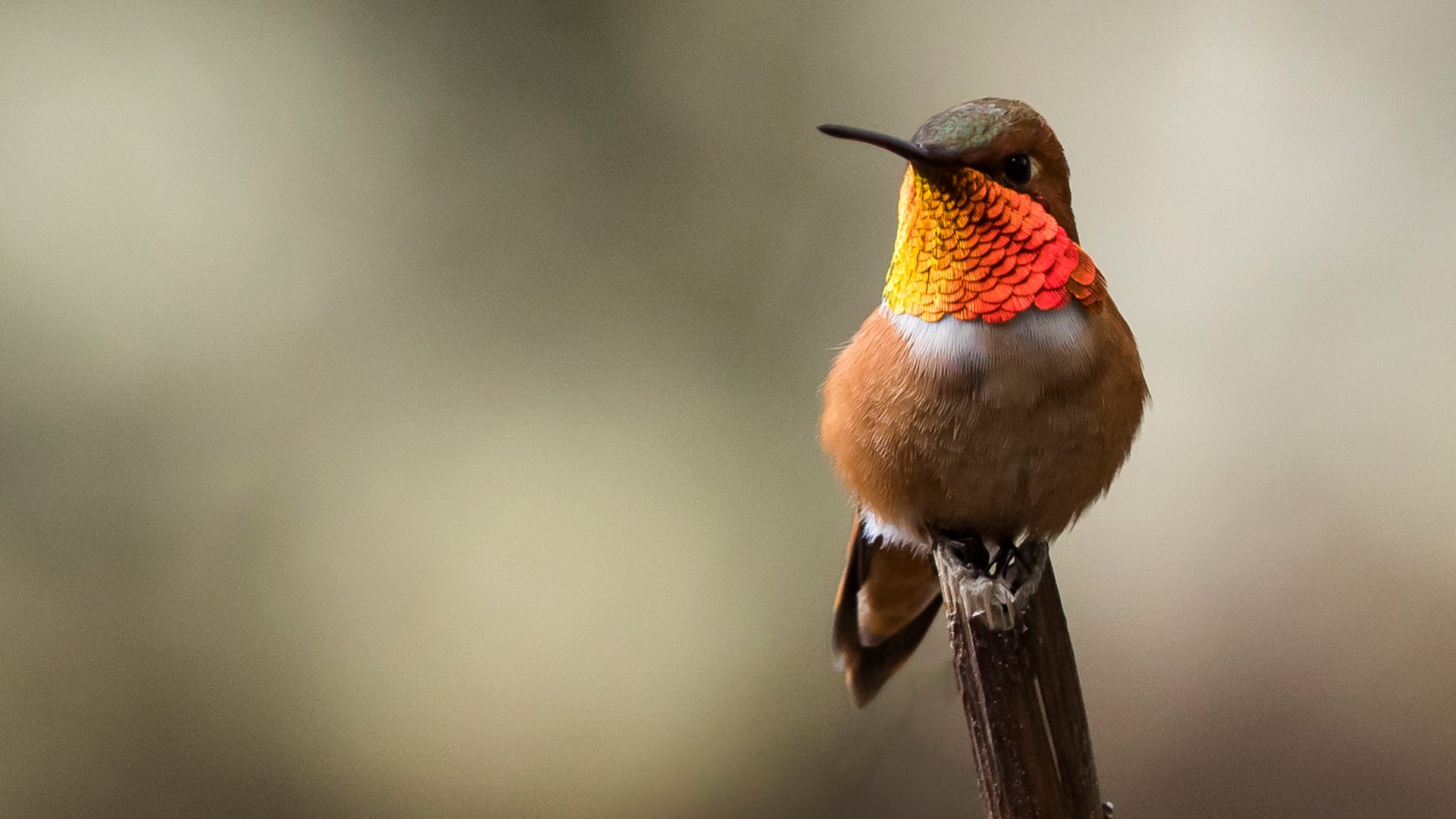Rufous Hummingbirds have the longest migration route of any other migratory hummingbird species. By now, their journey north is already underway, and many people have started spotting these feisty little hummingbirds at their hummingbird feeders all over the western U.S.!
About Rufous Hummingbirds
Known for their tenacity in tirelessly defending their stake at feeders and flowers, these small hummingbirds will chase away competing hummingbirds even if they are twice their size. A male Rufous has a shimmery orange coat on his back and belly with a distinguishing red throat. Females have green backs with reddish-brown (rufous-colored) sides and tails, and orange throats. Every spring, these amber-colored beauties make their long and tireless journey up the Pacific Coast to their breeding grounds in the North.
Rufous Hummingbird Migration Patterns
Rufous Hummingbirds reside almost exclusively on the Western half of North America, and travel all the way from southern Mexico to as far as Canada and Alaska during migration. That’s a journey of nearly 4,000 miles in just a few short months! Before a journey of this magnitude, Rufous Hummingbirds must begin fattening up to have extra energy stored for their flight. They will consume nectar from flowers and feeders for energy, and dine on nearby insects for protein.
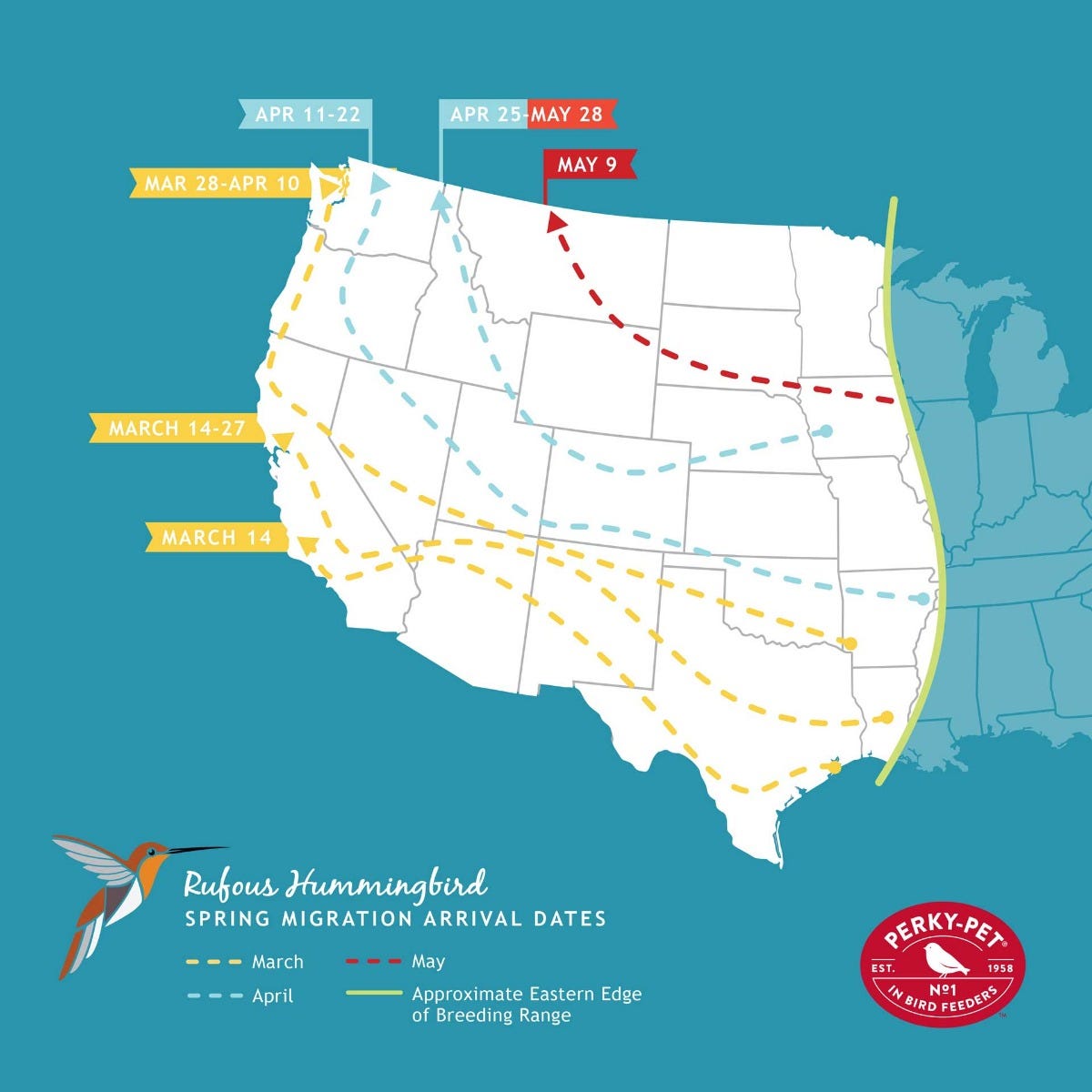
Rufous hummers usually start their northern migration earlier than any other migratory hummingbird species. They will leave their wintering destination of Mexico in January and begin making their journey up the Pacific Coast. Residents in southern California and Arizona have likely already spotted the first Rufous Hummingbirds of the season. The fast-flying hummers will make their way up the coastline and arrive in northwest states by late April. For those that breed in far north destinations including Alaska and Canada, they will arrive around mid-May.
By July, some will begin to make their southern migration back down to Mexico. Instead of following the same coastline migration route that they made on the journey north, Rufous Hummingbirds will make a sort of clockwise turn and come back down across the U.S. over the Rocky Mountains. It is during fall migration that people in Colorado, New Mexico and Arizona get the pleasure of spotting these energetic hummingbirds!
Why Migrate?
Only a handful of hummingbird species actually migrate each year. The majority of hummingbirds that migrate are the species that breed in the United States and Canada, like the Rufous. While hummingbirds drink nectar from flowers and feeders, they are also carnivores and need protein from insects to survive. Our winters up North are not optimal for insect populations to thrive or for flowers to grow and bloom, so these hummingbirds must go where their food supply is abundant – south.
Along with instinct, a few other elements trigger a Rufous Hummingbird to begin their northern and southern migration:
- Sun. As the seasons change, so does the angle of the sun and the amount of sunlight in each day. Even if seasonal weather patterns differ from year to year, the angle that the sun is shining will always change at a constant rate, alerting hummingbirds that the time to migrate is soon approaching.
- Weather. Weather doesn’t usually play a big factor as to when a hummingbird will begin migration. However, if there are particularly bad storms or heavy winds, hummingbirds might take shelter in a safe location for a few extra days until bad weather passes.
- Food Sources. Rufous Hummingbirds will travel from food source to food source as they become available along their migration route. The presence or disappearance of certain food sources in an area will signal to a migrating hummingbird that it’s time to begin their journey.
- Age. Mature hummingbirds will usually begin the journey first. Juveniles often need more time to fatten up and prepare for the long flight ahead.
Creatures of Habit
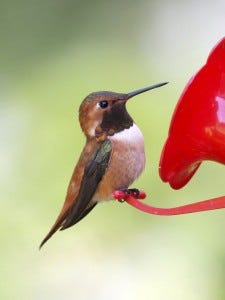
Rufous Hummingbirds have excellent memories. They often take the same route year after year, stopping at the same flowers and feeders along the way. This memory serves them well on their migration journey, as it is imperative that they find food sources throughout the day, and shelter at night.
If you have placed hummingbird feeders in your yard in years past, try to be consistent with putting them out in the same location and at the same times each year. Once you have a Rufous visitor, you will likely have him or her for years to come!
How You Can Help and Attract Rufous Hummingbirds
Spring and fall hummingbird migration are crucial times in a hummingbird’s life. If they don’t find enough food sources or safe shelter along their way, their chances of surviving the flight decrease.
A Rufous Hummingbird’s wings beat an average of 62 times per second, and they expend a great deal of energy just by flying! It’s imperative that they replenish the energy they use every day in order to avoid weakness and fatigue on their journey.
Here are a few things you can do to help make your yard the perfect place to attract Rufous Hummingbirds during their migration:
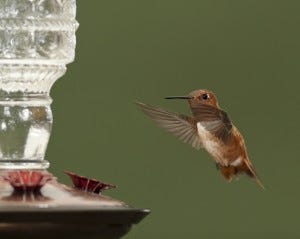
- Put Hummingbird Feeders Up Early and Keep Them Up Late. Since Rufous Hummingbirds are solo flyers, they will leave on their migration journey all at different times. Be sure to put your feeders out early in the spring if you’re on their northern route (near the Pacific Coast) to help any early arrivals that may come through. If you’re located on their southern journey near the Rocky Mountains, try to keep your feeders up later into the fall in case any hummers get a late start on their trip south.
- Hang Multiple Feeders. Rufous Hummingbirds are known to be very territorial. If you can, hang a few feeders in different locations throughout your yard to give other, less territorial hummers the chance to dine at your feeders as well.
- Clean Feeders Regularly. Try to hang your hummingbird feeders in a location that is somewhat shielded from the sun to prevent the nectar from spoiling. It’s important to change your hummingbird food every day or two, and thoroughly clean your feeders every few days to prevent mold from accumulating. If your nectar has spoiled, hummingbirds will stay away from your feeders and search for fresh nectar elsewhere.
- Plant Flowers. Rufous Hummingbirds also get nectar from certain flowers. Plant nectar-producing flowers such as fuchsias and columbines to attract hummingbirds to your yard.
- Provide Nesting Materials. Make your home inviting to breeding hummingbirds by not disposing of things in your yard that could be used for nesting materials. Hummingbirds will often use objects such as feathers, lichens, cotton and spider silk to create nests for raising their young.
Track the Hummingbird Migration
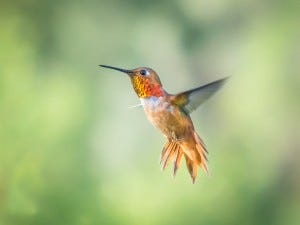
Hummingbird migration maps are useful tools that will help guide you as to when hummingbirds will be in your area. With the Perky-Pet® Hummingbird Migration Map, you can become a citizen scientist and submit your own hummingbird sighting. When submitting a sighting, you can add details such as the specific species you saw, the exact date of the visit and even upload a photo of the hummingbird in your yard!
It’s also helpful to use previous years’ migration maps to help you determine approximately when the hummingbirds will reach your area. Then, keep checking the current year’s map frequently and watch as they begin to make their way north, day by day!
Rufous Hummingbirds in Your Yard
Knowing when hummingbirds will be in your area can help you to take timely steps to support them along their journey. Keeping feeders full and fresh will assist in attracting these iridescent beauties to your backyard. And remember, once they know that your yard offers things like nectar and shelter, they will likely come back to visit year after year!
Be sure to check out our Species Spotlight and Species Library for more in-depth information about these feisty birds. Visit us on Facebook to share your own stories and pictures with the Perky-Pet® Community.
Also, subscribe to our e-newsletter to receive notifications about other great articles, as well as new products and great deals on bird feeding accessories.





